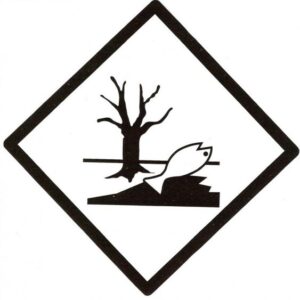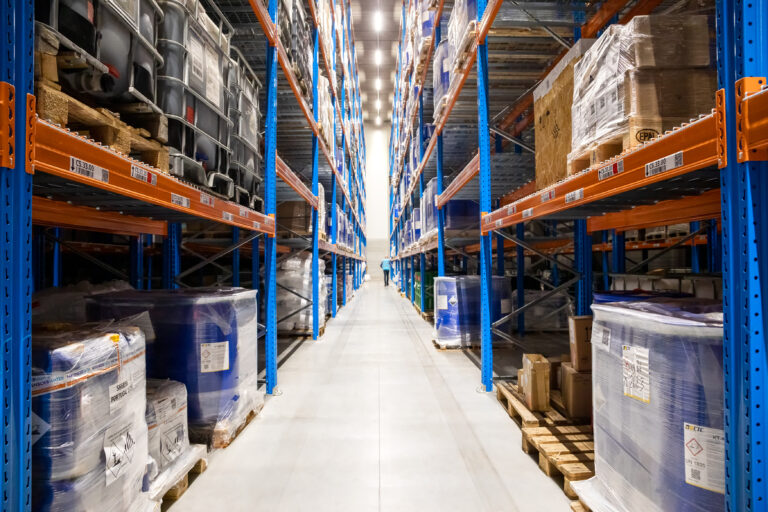When you think of dangerous goods, you may initially think of explosives, gases, fuels or chemical products, but they can also include substances and products that you would not immediately label as hazardous. These include cosmetic products, detergents and paint products. Even agents from the food industry can sometimes pose dangers.
In addition, more and more products are classified by manufacturers as environmentally hazardous substances under ADR (the international rules for the transport of dangerous goods by road). And in professional freight transport, especially distribution transport, it is almost inevitable that a driver will occasionally have to deal with the transportation of dangerous goods.

Want to make sure you handle dangerous goods safely? Then be sure to read on. We tell you how to recognize these substances and the laws and regulations governing transportation and storage. You’ll also discover what courses can help you ensure safe handling of dangerous goods.
How do you recognize dangerous goods?
Hazardous materials can be identified by hazard labels and UN numbers that must be on packages, containers and tanks, as well as information on the bill of lading.
Danger labels
The hazard characteristics of the various ADR hazard classes are indicated by the hazard labels below:

UN numbers
Which substances are subject to the requirements of the ADR regulations can be looked up in Tables 3.2A and 3.2B of the ADR. This lists substances by (transport) name or n.o.s. position (group name). Substances are linked to a globally used 4-digit identification number: the so-called UN number.
Hazard classes
Hazardous substances are classified into hazard classes based on their main hazard. The hazard class is expressed in numbers from 1 to 9 and is found on the hazard label. Below is an overview of the different hazard classes:
| 1 | Explosive substances and objects |
|---|---|
| 2 | Gases |
| 3 | Flammable liquids |
| 4.1 | Flammable solids / Self-depleting substances (liquid/solid) |
| 4.2 | Substances susceptible to self-ignition |
| 4.3 | Substances that develop flammable gas with water |
| 5.1 | Oxidizing substances |
| 5.2 | Organic peroxides (self-reactive) |
| 6.1 | Toxic substances |
| 6.2 | Infectious substances |
| 7 | Radioactive substances |
| 8 | Corrosive substances |
| 9 | Miscellaneous hazardous substances and objects |
Environmentally hazardous substances
Environmentally hazardous substances are harmful to the environment and/or human, animal and plant health. Some examples: pesticides, solvents and radioactive substances. These bear the following characteristics. To do so, check the consignor’s transport document.


The PGS: guidelines on the storage of dangerous goods
If you are going to store flammable, radioactive or explosive materials, it is important that you are aware of and comply with the rules governing them. These rules are contained in the Hazardous Substances Publication Series (Publicatiereeks Gevaarlijke Stoffen, PGS), among others. This is a series of publications providing guidelines for the storage, transportation and use of dangerous goods.
Some PGS directives with a large scope of application are PGS 15 (for the storage of packaged dangerous goods) and PGS 37-2 (for the storage of lithium-ion-containing energy carriers). The latter is expected to appear in final form in early 2024. Special Cargo College provides training on the PGS 15 and PGS 37-2.
Mandatory for many companies: in-house dangerous goods expert
The PGS 15 stip ulates that every company that can store more than 2,500 kg of dangerous goods must employ at least 1 expert to supervise it. So it is not enough to hire someone externally.
In any case, the expert must have the certificate of Competence in Handling Hazardous Substances (Vakbekwaamheid Behandeling Gevaarlijke Stoffen, VBGS). Special Cargo College offers the Hazardous Materials Handling Competency course, which is required to take the exam. So if your company is required to employ an expert, definitely consider signing up an employee for this.

International regulations for transportation of dangerous goods
For the transportation of dangerous goods, international regulations depend on the specific mode of transport:
All required training to learn how to apply these modalities can be taken at Special Cargo College.
Courses on working safely with dangerous goods
Special Cargo is a dangerous goods specialist and the training provider for logistics Netherlands in the field of dangerous goods, aviation safety and security. We offer a very wide range of courses.
Check out the different categories within our offerings below and find the courses and training that are valuable or required for your staff:







